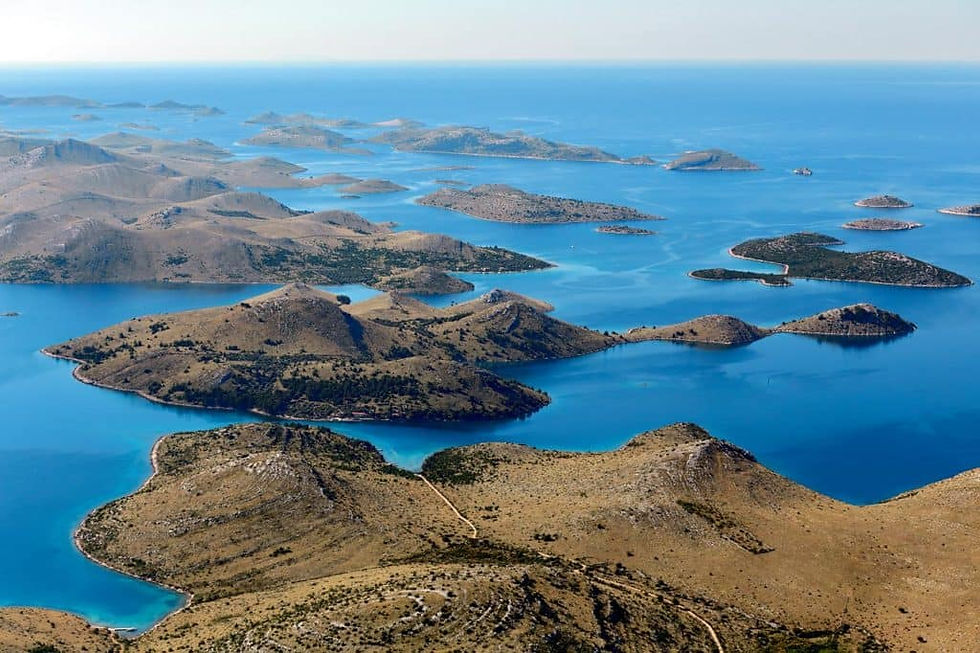In the Footsteps of God’s Last Creation: Kornati Islands
- T.B.
- Nov 29, 2024
- 3 min read

Kornati: Tears, Stars, and the Breath of God
If ever a place could live up to such poetic praise, it’s the Kornati Archipelago. Floating serenely in the central Adriatic between Šibenik and Zadar, this otherworldly collection of 89 islands is a masterpiece of nature’s imagination. Shaw's words perfectly encapsulate the ethereal beauty of these rocky sentinels, standing timeless amidst turquoise waters.
"On the last day of Creation, God desired to crown His work, and thus created the Kornati Islands out of tears, stars, and the breath of the sea." —George Bernard Shaw.

But Kornati isn’t just about aesthetics—it’s a mosaic of history, nature, and culture. Beneath the islands’ barren, lunar-like landscapes lies a vibrant story of coexistence between humans and the land. From Illyrian fortresses and Roman fishponds to intricate dry-stone walls and tiny chapels, these islands are as much a monument to Dalmatian heritage as they are to nature’s artistry.
A Land of Sheep, Donkeys, and Fish

One of the first things you’ll notice when you arrive in the archipelago is the sheep and donkeys grazing on the islands. These hardy animals, perfectly adapted to the sparse landscape, are often seen roaming freely, nibbling on the vegetation that thrives in this rocky haven. Their presence is a charming reminder of the simplicity and tranquillity of life here—a sharp contrast to the fast-paced world most visitors leave behind.
But life on Kornati isn’t limited to land. Beneath the shimmering waters lies an aquatic paradise. The crystal-clear seas teem with life, making it easy to spot schools of fish darting just below the surface. Whether you're snorkeling, diving, or simply gazing overboard, the vibrant marine ecosystem is bound to captivate you.
Kornati by the Numbers

The Kornati Archipelago spans 217 square kilometers, with 50 square kilometers of land and an impressive 167 square kilometers of marine life. At its heart lies Kornat, the largest island and namesake of the group. Declared a national park in 1980, the area was protected to preserve its stunning biodiversity and rich underwater ecosystems, making it a haven for marine life, history buffs, and travelers seeking untamed beauty.
Kornati’s Dramatic Cliffs
The Kornati’s defining feature is their dramatic cliffs, known as krune (crowns). These towering limestone formations, facing the open sea, tell a story millions of years in the making. Erosion and tectonic activity have carved these monumental structures, the tallest of which soars 82 meters above the sea on Klobučar Island. The longest stretches for a staggering 1,350 meters on Mana Island, offering an unparalleled view of this rocky paradise. Beneath the waves, the cliffs plunge nearly 100 meters, creating a sanctuary for marine life and divers alike.
When to Visit Kornati

Timing is everything when it comes to experiencing Kornati. Summer might be the obvious choice, but it’s also when the islands are packed with boats, selfie sticks, and the sound of tourists calling out, “Maria, look over here!” To truly feel the essence of Kornati, visit in late spring or early autumn. The weather is mild, the sea is warm, and the crowds are blissfully absent. It’s the perfect time to hike, swim, snorkel, and let yourself be enchanted by the islands' serenity.
Accessibility and Practicalities
Reaching Kornati is an adventure in itself. These islands are only accessible by boat, with the nearest mainland points being Murter (7 nautical miles) or Šibenik and Zadar (15 nautical miles). Two official park entrances,

Velika Proversa in the north and Opat Gate in the south, welcome visitors to this protected haven.
However, Kornati is as wild as it is beautiful. There’s no electricity grid, running water, or mobile signal on most islands. Electricity comes from solar panels and generators, while rainwater is collected in cisterns. There are no fuel stations or convenience stores, so plan accordingly. And if you’re thinking about bringing a drone—forget it!
A Hidden Movie Set: Mana Island
Among Kornati’s many treasures is Mana Island, where

you'll find ruins that aren’t exactly ancient but just as fascinating. Built in the 1950s for a film production, these stone structures—houses, storerooms, and even a church—have since become part of the islands' charm. Today, Mana’s ruins offer an unbeatable vantage point for soaking in the vastness of Kornati’s natural splendor.
Slow Travel and Timeless Beauty
Kornati is a place that demands patience and rewards contemplation. It’s not about checking off another destination but about immersing yourself in its raw, unpolished beauty. As advocates of slow tourism, we believe Kornati is best experienced without the rush—wander its trails, float in its crystal-clear waters, and simply be.
So bring your curiosity, your sense of wonder, and, yes, your camera. After all, a place born from tears, stars, and breath deserves to be remembered.



Comments